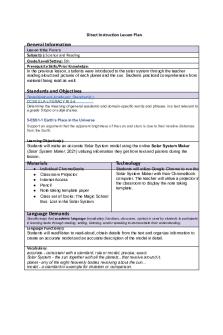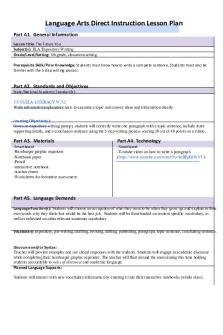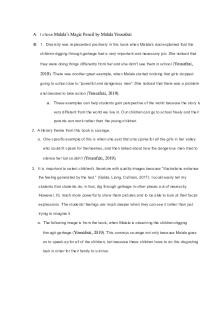HXM1 Task 1 pdf - lesson plan PDF

| Title | HXM1 Task 1 pdf - lesson plan |
|---|---|
| Author | Kyrsten Johnson |
| Course | Instructional Planning and Presentation |
| Institution | Western Governors University |
| Pages | 5 |
| File Size | 170.9 KB |
| File Type | |
| Total Downloads | 7 |
| Total Views | 136 |
Summary
lesson plan...
Description
Kyrsten Johnson HXM1 Task 1
Part A: Lesson Title: Magic Magnets Subject(s): Science Grade/Level/Setting: I am self-contained general education 3rd grade teacher. My class consists of a variety of mixed ability students from various backgrounds. There are 28 students total in my class, specifically 16 boys and 12 girls. 19 of those students are ongrade-level readers while 5 are reading two grade levels above their target reading level (2 are identified as gifted/talented). 2 of the students are English language learners at the intermediate level and 2 students are identified as having special needs. *Students will be seated in rows facing the projector screen. Prerequisite Skills/Prior Knowledge: * Students are capable of completing a worksheet. * Students are aware of what a magnet is. * Students are able to make new discoveries.
State/National Academic Standard(s): 3.PS2 1) Explain the cause and effect relationships of magnets. 2) Solve a problem by applying the use of of the interactions between two magnets. Learning Objective(s): Students will be able to use their knowledge of magnetism to solve a problem or respond to a situation; Students will show proficiency by completing 2 of the 3 worksheets provided.
Materials: Pencil Worksheets Magnets Various items found within the classroom
Technology: I will be using an ELMO and a projector screen to mirror the vocabulary terms in order to provide whole class instruction while ensuring each student can see each definition and subject specific term.
Language Function(s): The main idea of this lesson is for students to understand magnetism. Students will identify what materials are magnetic. Students will explain the relationship between magnets and various materials. Students will analyze 3 given problems and determine solutions to the given problems.
Vocabulary: attract, repel, iron, magnet, magnetism, opposites, poles, strength
Discourse and/or Syntax: When students are put into groups for determining which items in the room are magnetic, students will engage in conversation with vocabulary, specific to the lesson.
Planned Language Supports: Students will have vocabulary list in hand during the group activity for reference and magnets to use for determining whether an object is magnetic or not.
Instructional Strategies and Learning Tasks Anticipatory Set: Activity Description/Teacher
Student Actions
*Teacher will model the 3 worksheets. using the Elmo and a projector to engage in a class discussion/lecture about different ways to solve problems by using magnets.
*Students will be seated in the classroom facing the projector screen and shown the 3 worksheets they are to complete.
Presentation Procedures for New Information/Modeling Activity Description/Teacher
Student Actions
*Teacher will mirror vocabulary words using the Elmo and projector screen to aid students in understanding the subject specific vocabulary.
*Students will write the definition of each subject specific vocabulary word. As the teacher explains and completes each word students will be expected to write the definitions on his or her own vocabulary page.
Guided Practice Activity Description/Teacher
Student Actions
*During the activity, the teacher will be circling and monitoring the students to ensure they are staying on task and will be available for any assistance while maintaining classroom safety.
*Students will be in 7 groups with 4 students per group to complete the given worksheets and find solutions to real life problems presented in the worksheets. Students will be allowed to use magnets and move about the classroom to test various object’s magnetism.
Independent Student Practice Activity Description/Teacher
Student Actions
*As students complete their worksheets the teacher will be monitoring each group to ensure student understanding and success.
*When students are placed into groups, they will work with each other to produce solutions to the given problems within the worksheets. Students will discuss their findings within their group and come to a suitable solution as a group to ensure success and understanding. Students must complete 2 of the 3 worksheets within the given time frame to show proficiency.
Closing or Closing Procedure/Activity Activity Description/Teacher
Student Actions
*As a review, the teacher will as the Students if there were any revisions Or different strategies they would make After the activity is completed.
As a class, students can reflect on their answers and solutions and give any alternate solutions or revisions they have have.
Differentiated Instruction Gifted and Talented: An enrichment I could use for the gifted and talented students would be placing them into heterogeneous groups and allow them to guide other students that may need a little extra guidance for the activity.
EL: To support my EL students, I can use one-on-one coaching to ensure that they are understanding the vocabulary words and the activity to ensure their success.
Students with Other Special Needs: If any of the students had another special need, such as ADHD, I would allow the students to have the magnet during the activity. This student would be the official “magnetism checker” for the group as I feel this would keep the student’s attention and promote engagement.
Assessment: Formative: Observation plays an important role in measuring how much the students understand this lesson. I will be circulating the room to observe if the students are understanding both the vocabulary from this lesson as well as the activity part of the assignment. I will be readily available if a student or group of students needs extra guidance or probing questions to assist in their own understanding.
Summative: The summative assessment for this lesson will be the completion of the worksheets provided. The students will have to complete 2 of the 3 worksheets given to them to show proficiency of this lesson.
Part B: Active Participation-Direct Instruction: In this lesson the students will receive direct in structure in order to learn new subject-specific vocabulary and receive instructions on how to complete the
activity. The teacher will be giving definitions, by use of an Elmo and projector screen, for term vocabulary while the students copy the definitions onto their own vocabulary sheets. The students will then read over the vocabulary and given instructions for the group activity to ensure understanding and will ask for assistance if needed. Renard states that with direct instruction implemented correctly, all students, regardless of history and background, can learn (Renard, 2019). Grouping Strategy-Heterogeneous Grouping: For this lesson, the students are placed into 7 heterogeneous groups with 4 students per group. By placing the students into heterogeneous groups, the students have the ability to learn from each other. The more advanced students can act as a guide for the students who may be struggling whereas some students may think “outside the box” and offer a different solution not previously thought of. Heterogeneous grouping is both socially and academically beneficial to a class and according to Bainbridge it (heterogeneous grouping) can be helpful for students with different learning skills and types (Bainbridge,2020).
Technology Strategy-Elmo (document camera) and projector screen: For this lesson, the teacher will be using an Elmo (document camera) and a projector screen as a technology paid to promote fairness and understanding for the class. The teacher will model the exact vocabulary sheet that each student has by projecting it from the Elmo onto the screen. By doing this, the students get real time answers and feedback for their lesson. By having real time answers, the students can spend less time figuring out if they have the correct information and more time for completing the upcoming activity. As Lutes has suggested, document cameras (the Elmo) allows teachers to make the thinking process come come alive for the students (Lutes,2015).
Formative Assessment Strategy- Interview Assessments: The formative assessment strategy the teacher uses for this lesson is a group interview assessment. After the grouping activity and the students have completed their worksheets, they will meet at the community area to discuss their discoveries. The teacher will then take 5 to 10 minutes to casually chat with the students to determine their level of understanding of the lesson. As Thomas points out, interview assessments can help the students feel at ease while giving the teacher a sense of what they know (Thomas,2019).
References: Renard, Lucie. 2019. Direct Instruction-A practical guide to effective teaching. Retrieved from https://www.bookwidgets.com/blog/2019/03/ direct-instruction-a-practical-guide-to-effective-teaching.
Bainbridge, Carol. 2020. Pros and Cons of Heterogeneous Grouping in Classrooms. Retrieved from https://www.verywellfamily.com/ heterogeneous-grouping-1449185.
Lutes, Bryn. 2015. Encouraging Critical Thinking with a Document Camera. Retrieved from https://ctl.wustl.edu/encouraging-critical-thinking-with-adocument-camera/.! Thomas, Laura. 2019. 7 Smart, Fast Ways to Do Formative Assessment. Retrieved from https://www.edutopia.org/article/7-smart-fast-ways-doformative-assessment.!...
Similar Free PDFs

HXM1 Task 1 pdf - lesson plan
- 5 Pages

Task 1 - Lesson Plan
- 6 Pages

Task 1 - Lesson Plan
- 8 Pages

Lesson Plan task 1
- 6 Pages

BDM2 Task 1 lesson plan
- 15 Pages

Lesson Plan / task
- 7 Pages

Lesson Plan - - Task 2
- 7 Pages

Task 1 Math Tools lesson plan
- 13 Pages

C732 Task 1 Lesson Plan - Passed
- 6 Pages

Geometry Task 2 Lesson Plan
- 7 Pages

C365 Lesson Plan Task 1.docx
- 8 Pages

C970 Lesson - Task 1
- 15 Pages
Popular Institutions
- Tinajero National High School - Annex
- Politeknik Caltex Riau
- Yokohama City University
- SGT University
- University of Al-Qadisiyah
- Divine Word College of Vigan
- Techniek College Rotterdam
- Universidade de Santiago
- Universiti Teknologi MARA Cawangan Johor Kampus Pasir Gudang
- Poltekkes Kemenkes Yogyakarta
- Baguio City National High School
- Colegio san marcos
- preparatoria uno
- Centro de Bachillerato Tecnológico Industrial y de Servicios No. 107
- Dalian Maritime University
- Quang Trung Secondary School
- Colegio Tecnológico en Informática
- Corporación Regional de Educación Superior
- Grupo CEDVA
- Dar Al Uloom University
- Centro de Estudios Preuniversitarios de la Universidad Nacional de Ingeniería
- 上智大学
- Aakash International School, Nuna Majara
- San Felipe Neri Catholic School
- Kang Chiao International School - New Taipei City
- Misamis Occidental National High School
- Institución Educativa Escuela Normal Juan Ladrilleros
- Kolehiyo ng Pantukan
- Batanes State College
- Instituto Continental
- Sekolah Menengah Kejuruan Kesehatan Kaltara (Tarakan)
- Colegio de La Inmaculada Concepcion - Cebu



